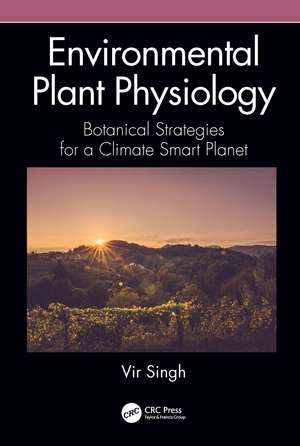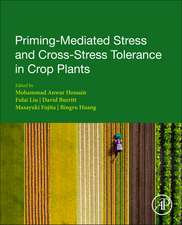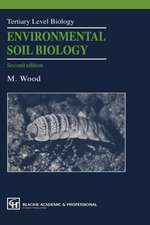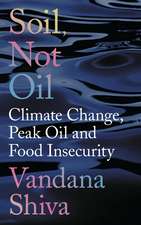Environmental Plant Physiology: Botanical Strategies for a Climate Smart Planet
Autor Vir Singhen Limba Engleză Hardback – 3 feb 2020
Environmental Plant Physiology provides a stupendous knowledge source for undergraduate and graduate students and their teachers in many inter-related disciplines, like life sciences, agricultural sciences, environmental sciences, ecology, and climatology. Further, this book can also be of vital importance for policy makers and organizations dealing with climate related issues and committed to the cause of the Earth. This book can be instrumental in formulating strategies that can lead us to a climate smart planet.
Features:
- Ecological basis of environmental plant physiology.
- Energy, nutrient, water, temperature, allelochemical and altitude relations of plants.
- Stress physiology of plants.
- Climate change effects on plant physiology.
- Plants' adaptations to the changing climate.
- Evolving botanical strategies for a climate smart planet.
Preț: 782.44 lei
Preț vechi: 954.19 lei
-18% Nou
149.77€ • 162.74$ • 125.89£
Carte tipărită la comandă
Livrare economică 21 aprilie-05 mai
Specificații
ISBN-10: 036703042X
Pagini: 230
Ilustrații: 63
Dimensiuni: 178 x 254 x 14 mm
Greutate: 0.45 kg
Ediția:1
Editura: CRC Press
Colecția CRC Press
Cuprins
Preface...............................................................................................................................................xi
Acknowledgments .......................................................................................................................... xiii
Author ..............................................................................................................................................xv
Chapter 1 Environment and Ecosystems: Physiological Basis of Ecology ...................................1
The Lumenosphere .......................................................................................................1
The Biosphere ...............................................................................................................2
The Organism-Environment Relationships ..................................................................3
Energy and Nutrient Flows through Ecosystems ....................................................4
Food Chains .............................................................................................................5
Food Web .................................................................................................................6
Ecological Pyramids ................................................................................................7
Ecological Pyramid of Numbers ........................................................................7
Ecological Pyramid of Biomass .........................................................................8
Ecological Pyramid of Energy ...........................................................................9
The Sixth Trophic Level ........................................................................................ 10
The Seventh Trophic Level .................................................................................... 10
What Is Environmental Physiology? .......................................................................... 11
Climate and Its Changing Behavior ........................................................................... 12
Scope of Environmental Plant Physiology ................................................................. 13
Applications in Food Production ........................................................................... 13
Environmental Physiology: The Basis for a Climate-Smart Planet ........................... 14
Summary .................................................................................................................... 17
References .................................................................................................................. 18
Websites ...................................................................................................................... 18
Chapter 2 Energy Relations ........................................................................................................ 19
Energy and Life .......................................................................................................... 19
Trophic Diversity in Nature ........................................................................................ 19
The Light of Life ........................................................................................................20
Leaf and Light ............................................................................................................ 21
Leaf-Energy Balance .............................................................................................22
Energy Inputs and Energy Outputs of a Leaf ...................................................24
Net Radiation ....................................................................................................24
Sensible Heat Loss (Conduction and Convection) ............................................25
Latent and Chemical Energy ............................................................................25
Photosynthetic Pathways ............................................................................................26
C3 Photosynthesis ..................................................................................................27
C4 Photosynthesis ..................................................................................................28
CAM Photosynthesis .............................................................................................29
E = mc2 in the Context of Earth’s Ecosystems...........................................................30
Sun–Soil–Plant: The Evolutionary Ladder of Life .................................................... 31
Photosynthesis and Soil Fertilization .................................................................... 32
Energy from Inorganic Molecules ............................................................................. 33
Energy from Organic Molecules ................................................................................ 35
Chemical Composition vis-à-vis Nutrient Requirements ...................................... 35
Herbivory ...............................................................................................................36
Carnivory ...............................................................................................................36
Detritivory ............................................................................................................. 37
Energy Limitations .....................................................................................................38
Optimal Foraging by Animals ..............................................................................38
Optimal Foraging by Plants................................................................................... 39
Energy Flow in the Biosphere .................................................................................... 39
Summary .................................................................................................................... 41
References .................................................................................................................. 42
Websites ...................................................................................................................... 43
Chapter 3 Nutrient Relations ....................................................................................................... 45
The Pedosphere .......................................................................................................... 45
Soil as an Ecosystem .................................................................................................. 45
Diversity of the World’s Soils .....................................................................................46
Soil Types .............................................................................................................. 47
Soil Biodiversity .................................................................................................... 47
Pedodiversity–Biodiversity Relations ....................................................................48
Essential Elements ......................................................................................................49
Sources of Plant Nutrients ..........................................................................................50
Nutrient Availability for Plants .................................................................................. 51
Interactions among Ions ............................................................................................. 51
Cycles in the Soil ........................................................................................................ 53
Ion-Uptake Physiology ...............................................................................................54
Kinetics ..................................................................................................................54
Internal Control ..................................................................................................... 58
Morphological Responses .......................................................................................... 59
Root:Shoot Ratio and Root:Weight Ratio .............................................................. 59
Root Diameter and Root Hairs ..............................................................................60
Root Density and Distribution ...............................................................................60
Soil Microorganisms .................................................................................................. 61
Rhizosphere ........................................................................................................... 61
Impact on Nutrient Uptake .................................................................................... 62
Nitrogen Fixation ................................................................................................... 62
Influence of Environmental Factors ......................................................................63
Mycorrhizas ...........................................................................................................64
Summary ....................................................................................................................65
References ..................................................................................................................66
Websites ...................................................................................................................... 67
Chapter 4 Water Relations ..........................................................................................................69
The Water Planet as Home to Life .............................................................................69
Water Properties Conducive to Life ...........................................................................69
Water Availability to Organisms ................................................................................ 70
Water in Air ........................................................................................................... 70
Water Movement within Water .............................................................................. 71
Water Potential ........................................................................................................... 72
Plant Roots and Water Acquisition............................................................................. 74
Water Relations of Plant Cells .................................................................................... 75
Supply of Water by the Soil ........................................................................................ 76
Water Planet a Climate-Smart Planet.........................................................................77
Summary .................................................................................................................... 78
References .................................................................................................................. 79
Websites ...................................................................................................................... 79
Chapter 5 Temperature Relations ................................................................................................ 81
Microclimatic Variations and Temperatures .............................................................. 81
Atmospheric Trends vis-à-vis Altitudes ..................................................................... 81
Troposphere ...........................................................................................................84
Stratosphere ...........................................................................................................85
Mesosphere ............................................................................................................86
Thermosphere ........................................................................................................86
Exosphere ..............................................................................................................87
Plant–Temperature Relations ......................................................................................87
Ground Color and Temperatures ................................................................................88
Vegetation and Temperatures .....................................................................................88
Slope Aspects and Temperatures ...............................................................................89
Aquatic Environments’ Temperatures ........................................................................89
Photosynthesis in Extreme Temperatures ..................................................................90
Solar Energy–Temperature Interaction ...................................................................... 91
Temperature Regulation by Plants ............................................................................. 91
Arctic and Alpine Plants ....................................................................................... 91
Tropical Alpine Plants ...........................................................................................93
Desert Plants ..........................................................................................................94
Temperature Regulation by Thermogenic Plants ..................................................94
Adaptation to Harsh Environments ............................................................................96
Physiological Strategies for Cooling the Earth ..........................................................97
Summary ....................................................................................................................99
References ................................................................................................................ 100
Websites .................................................................................................................... 101
Chapter 6 Allelochemical Relations ......................................................................................... 103
Competition among Plants ....................................................................................... 103
Defining Competition .......................................................................................... 103
Competition within Plant Populations ................................................................. 104
Asymmetric Competition .................................................................................... 104
Interspecific Competition: Mixed-Species Analysis ........................................... 105
Allelopathy ............................................................................................................... 105
Chemical Interactions among Plants ........................................................................ 106
Nature of Allelopathy ............................................................................................... 107
Allelopathic Plants ................................................................................................... 107
Allelopathy Applications in Agriculture .................................................................. 109
Cropping Systems’ Management ......................................................................... 109
Mulching for Weed Control ................................................................................. 109
Ecologically Healthy Agrochemicals and Microbial Pesticides ......................... 110
Breeding the Allelopathic Cultivars .................................................................... 110
Reducing NO3 Leaching and N2O Pollution........................................................ 111
Allelopathic Mechanisms ......................................................................................... 111
Effect on Soil Ecology ......................................................................................... 111
Effect on Photosynthesis ..................................................................................... 111
Effect on Respiration ........................................................................................... 112
Effect on Enzyme Functions ............................................................................... 113
Influence on Plant-Growth Regulator System ..................................................... 113
Effect on Antioxidant System .............................................................................. 114
Effect on Protein and Nucleic-Acid Synthesis .................................................... 114
Effect on Water and Nutrient Uptake .................................................................. 114
Effect on Cell Division and Elongation ............................................................... 114
Phytosociology for a Greener Planet ........................................................................ 117
Summary .................................................................................................................. 118
References ................................................................................................................ 119
Websites .................................................................................................................... 120
Chapter 7 High-Altitude Physiology ......................................................................................... 121
Altitude Types from Sea Level ................................................................................. 121
High-Altitude Specificities ....................................................................................... 122
Diverse Ecological Niches ................................................................................... 122
Biodiversity .......................................................................................................... 123
Fragility ............................................................................................................... 123
Adaptation Mechanisms ...................................................................................... 125
Marginality .......................................................................................................... 125
Poor Accessibility ................................................................................................ 126
High-Altitude Plant Ecology .................................................................................... 126
Effects of Altitudes on the Physiology of the Plants ................................................ 128
Photosynthesis ..................................................................................................... 128
Respiration ........................................................................................................... 130
Transpiration ........................................................................................................ 130
Chlorophyll Destruction ...................................................................................... 131
Resistance to Ultraviolet Radiation ..................................................................... 131
Frost Resistance ................................................................................................... 132
Water Balance and Avoidance of Desiccation ..................................................... 132
Growth and Development .................................................................................... 133
High Altitudes: Cooling Breeze for Cooling the Mainstream World ...................... 134
Summary .................................................................................................................. 135
References ................................................................................................................ 137
Websites .................................................................................................................... 138
Chapter 8 Stress Physiology ...................................................................................................... 139
Stress to Life as an Inevitable Phenomenon ............................................................. 139
Solar-Radiation Stress .............................................................................................. 140
Temperature Stress ................................................................................................... 141
Effects on Photosynthesis and Respiration.......................................................... 141
Effect on Membranes and Enzymes .................................................................... 141
Effects of Freezing Temperatures........................................................................ 142
Stress of Oxygen Deficiency .................................................................................... 142
Molecular Genetics Aspects of Oxygen-Deficiency Stress ................................. 143
Root Damage in Anoxic Environments ............................................................... 144
Effect of Anoxia-Damaged Roots on Shoots ...................................................... 145
Synthesis of Anaerobic Stress Proteins ............................................................... 145
Salinity Stress ........................................................................................................... 145
Effect on Photosynthesis and Growth ................................................................. 146
Osmotic and Specific Ion Effects ........................................................................ 147
Plants’ Strategies of Saline Stress Management ................................................. 147
Heat Stress ................................................................................................................ 148
Water Deficit and Heat Stress .............................................................................. 148
Effect on Photosynthesis and Respiration ........................................................... 148
Effect on Cell Membrane .................................................................................... 149
Adaptation Mechanisms against Heat Stress ...................................................... 149
Low-Temperature Stress ........................................................................................... 150
Chilling Effects on Cell Membrane .................................................................... 150
Tolerance to Cold Stress ...................................................................................... 151
Pollution Stress on Ecosystems ................................................................................ 153
Heavy-Metal Stress .................................................................................................. 154
Reactive Oxygen Species ..................................................................................... 154
Inactivation of Biomolecules ............................................................................... 155
Primary Stress ..................................................................................................... 155
Secondary Stress ................................................................................................. 155
Signal Transduction ............................................................................................. 155
Effects on Cellular Components .......................................................................... 155
Heavy-Metal Detoxification Methods ................................................................. 155
Vacuolar Compartmentalization.......................................................................... 157
Pollution Stress Impacts on Ecological Processes ................................................... 157
Water Stress .............................................................................................................. 158
The Etiology of Water Stress ............................................................................... 159
Multidimensional Nature of Water Stress ........................................................... 159
Morphological, Anatomical, and Cytological Changes ................................. 160
Photosynthesis ................................................................................................ 160
Protein Synthesis ............................................................................................ 161
Proline Accumulation ..................................................................................... 161
Lipids .............................................................................................................. 162
Mineral Nutrition ............................................................................................ 162
Abscisic Acid Accumulation .......................................................................... 162
Oxidative Stress .............................................................................................. 162
Summary .................................................................................................................. 163
References ................................................................................................................ 164
Websites .................................................................................................................... 166
Chapter 9 Physiological Effects of Climate Change ................................................................. 167
Living in an Age of Climate Change ....................................................................... 167
The Factors Affecting the Earth’s Climate .............................................................. 168
Enhanced Greenhouse Effect ................................................................................... 169
Overriding the Earth’s Potencies .............................................................................. 171
Impact of Climate Change on Plant Physiology ...................................................... 173
Microevolutionary Responses of Plant Physiology to Climate Change .............. 175
Phenotypic Plasticity ...................................................................................... 176
Adaptive Evolution ......................................................................................... 176
Gene Flows ..................................................................................................... 176
Macroevolutionary Responses of Plant Physiology to Climate Change ............. 177
Species Interactions and the Evolution of Plant Physiology in Response to
Climate Change ........................................................................................................ 179
Effects of Climate Change on Forest Ecosystems ................................................... 180
Forest Productivity .............................................................................................. 180
Forest Distribution ............................................................................................... 181
Forest Ecosystem Disturbances ........................................................................... 181
Forest Pests .......................................................................................................... 182
Impact on Forest Community .............................................................................. 182
Climate Change and Agriculture ............................................................................. 183
Coping with Climate Change ................................................................................... 189
Preparedness ........................................................................................................ 189
Adaptation ........................................................................................................... 190
Mitigation ............................................................................................................ 190
Climate-Smart Planet: A Sustainable Planet ........................................................... 191
Ecological Integrity and Ecological Security ...................................................... 191
Living Soil to Nurture the Roots of Life ............................................................. 192
Forests for a Healthy, Vibrant, and Sustainable Planet ....................................... 193
Climate-Smart Agriculture ...................................................................................... 196
Why an Agroecosystem Approach to Food Production? .................................... 197
Agroecology: The Philosophy of Food Production ............................................. 198
Enhanced Biodiversity Complexity ................................................................ 199
Treating Soil as an Ecosystem ........................................................................ 199
Maintaining Cyclic Flows of Nutrients .......................................................... 199
Vegetarianism: The Philosophy of Earth-Caring Nutrition ..................................... 201
Summary ..................................................................................................................203
References ................................................................................................................204
Websites ....................................................................................................................207
Index ..............................................................................................................................................209
Notă biografică
Recenzii
--S. T. Meiers, emerita, Western Illinois University, Choice, 2020 Vol. 58 No. 4
Descriere
Environmental Plant Physiology provides a stupendous knowledge source for undergraduate and graduate students and their teachers in many inter-related disciplines, like life sciences, agricultural sciences, environmental sciences, ecology, and climatology. Further, this book can also be of vital importance for policy makers and organizations dealing with climate related issues and committed to the cause of the Earth. This book can be instrumental in formulating strategies that can lead us to a climate smart planet.
Features:
- Ecological basis of environmental plant physiology.
- Energy, nutrient, water, temperature, allelochemical and altitude relations of plants.
- Stress physiology of plants.
- Climate change effects on plant physiology.
- Plants' adaptations to the changing climate.
- Evolving botanical strategies for a climate smart planet.




















